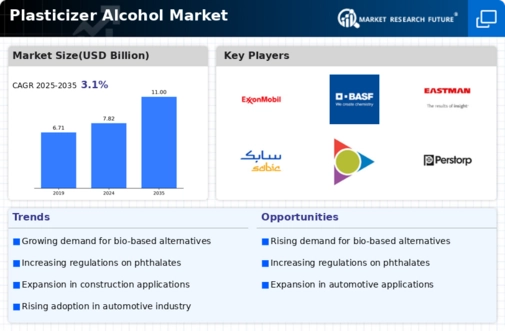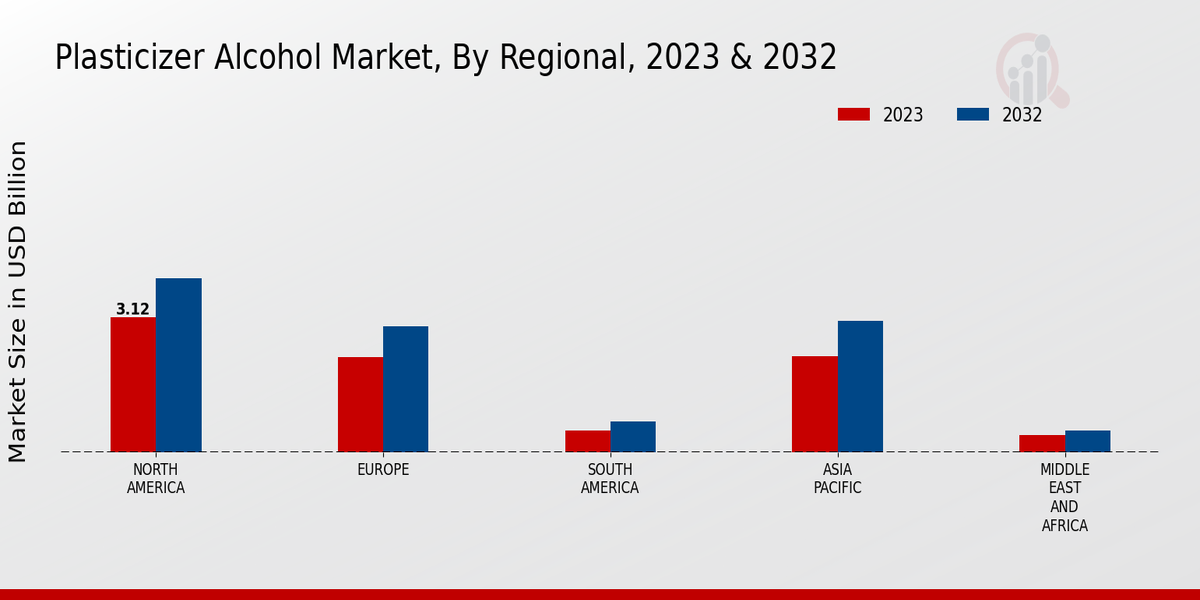Market Growth Chart
The Global Plasticizer Alcohol Market Industry is projected to experience substantial growth over the coming years. The market is expected to reach a value of 7.82 USD Billion in 2024, with a forecasted increase to 11.0 USD Billion by 2035. This growth trajectory indicates a CAGR of 3.13% from 2025 to 2035, reflecting the industry's resilience and adaptability in response to evolving market demands.
Rising Demand for Eco-Friendly Products
The Global Plasticizer Alcohol Market Industry experiences a notable increase in demand for eco-friendly products. As consumers become more environmentally conscious, manufacturers are compelled to adopt sustainable practices. This shift towards greener alternatives is evident in the growing preference for bio-based plasticizers, which are derived from renewable resources. For instance, the market for bio-based plasticizers is projected to expand significantly, contributing to the overall growth of the Global Plasticizer Alcohol Market Industry. This trend aligns with the anticipated market value of 7.82 USD Billion in 2024, reflecting a broader commitment to sustainability in manufacturing processes.
Expanding Applications Across Industries
The versatility of plasticizer alcohols contributes to their expanding applications across diverse industries, thereby driving growth in the Global Plasticizer Alcohol Market Industry. These compounds are utilized in sectors such as construction, automotive, and consumer goods, where they enhance flexibility and durability of materials. For instance, in the construction industry, plasticizer alcohols are essential for producing high-performance concrete. This widespread applicability is likely to bolster the market's value, projected to reach 7.82 USD Billion in 2024, as manufacturers increasingly recognize the benefits of incorporating plasticizer alcohols into their products.
Technological Advancements in Production
Technological innovations play a pivotal role in the Global Plasticizer Alcohol Market Industry. Advances in production techniques enhance efficiency and reduce costs, thereby attracting more manufacturers to the sector. For example, the adoption of continuous production processes allows for higher output and improved product quality. These advancements not only streamline operations but also contribute to the market's projected growth, with an expected value of 11.0 USD Billion by 2035. As technology continues to evolve, it is likely that the Global Plasticizer Alcohol Market Industry will witness further enhancements, fostering competitiveness and sustainability.
Growing Awareness of Health and Safety Concerns
Heightened awareness regarding health and safety concerns is reshaping the Global Plasticizer Alcohol Market Industry. As consumers and industries become more informed about the potential risks associated with traditional plasticizers, there is a marked shift towards safer alternatives. This trend is particularly evident in the food packaging and medical sectors, where compliance with safety standards is paramount. Consequently, manufacturers are investing in research and development to create non-toxic plasticizer alcohols, which is expected to drive market growth. The anticipated market value of 11.0 USD Billion by 2035 underscores the importance of addressing health and safety issues in product development.
Regulatory Support for Plasticizer Alternatives
Regulatory frameworks increasingly support the transition towards safer plasticizer alternatives, significantly impacting the Global Plasticizer Alcohol Market Industry. Governments worldwide are implementing stricter regulations on harmful substances, prompting manufacturers to seek compliant alternatives. This regulatory landscape encourages innovation and the development of safer plasticizers, which are crucial for various applications, including construction and automotive industries. As a result, the market is expected to grow at a CAGR of 3.13% from 2025 to 2035, reflecting the positive influence of regulatory support on the industry.














